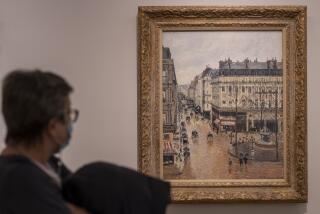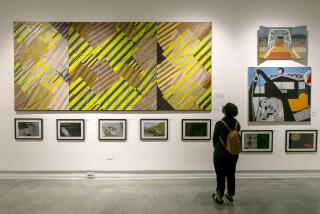Germany raid yields 1,500 artworks possibly seized by Nazis
LONDON — The elderly gentleman appeared nervous when authorities questioned him during a customs check aboard a train from Switzerland to Germany. He was carrying about $12,000 in cash, just within the legal limit.
But a feeling that something was not quite right eventually led them several months later to raid the apartment in Munich where the man lived as a recluse.
What they found was astonishing: paintings by Pablo Picasso, Marc Chagall, Henri Matisse and Paul Klee among 1,500 works of art crammed amid piles of canned food. Some or all of the art, estimated to be worth $1.3 billion or more, was thought to have been looted by the Nazis more than 70 years ago. That would make it one of the largest such troves recovered since World War II.
The stunning find was reported Sunday by the German newsmagazine Focus. It said the collection found in the possession of Cornelius Gurlitt, the 80-year-old son of a well-know Nazi-era art dealer, included pieces that were thought to have been lost or destroyed during the war.
“It is the largest cache held by a private individual illegally — by miles,” Julian Radcliffe, chairman of the Art Loss Register in London, which tracks vanished works of art, said Monday. “Two years ago we found a dealer who had two stolen pictures in his safe when he died, and we thought that was pretty shocking because he had actually been put in jail by the French in 1946 for being part of the Holocaust looting.... To find one on this scale is exceptional.”
Overall, the Nazis are suspected of plundering 650,000 paintings and other artworks, which puts the Munich hoard, for all its unprecedented size, into grim perspective.
Robert Edsel, author of the book “The Monuments Men,” which chronicles the search for and recovery of art looted during World War II, said the discovery validated the view that what had been discovered so far was the tip of the iceberg.
“The theft is being solved in what seems like slow motion — one day there might be a story, but the only people following it are art historians or people who follow Nazi looting,” said Edsel, whose book is being made into a movie starring George Clooney, Matt Damon and Bill Murray. It will be released early next year.
Edsel said he was working with filmmakers on a project to be announced late this month that will ask the public’s help in expediting the recovery of still-missing works of art.
Gurlitt’s home was raided in early 2011, Focus reported. German authorities have kept mum as they moved the items into safe storage outside Munich and started to untangle the knot of issues surrounding provenance and rightful ownership.
The German government told reporters Monday that it was notified of the haul several months ago by Bavarian officials and that it was assisting with the investigation.
Many of the original collectors could turn out to be Jewish families who saw their belongings confiscated by the Nazis or who sold them at knock-down prices in their desperation to flee Europe and avoid deportation to the extermination camps.
That the authorities in Bavaria, in southern Germany, took so long to acknowledge their astounding discovery and have yet to publish an inventory disturbs some advocates of reuniting stolen art with their proper owners.
“It doesn’t take 2 3/4 years to do that,” said Anne Webber, co-chair of the Commission for Looted Art in Europe, a nonprofit organization. “There’s a complete lack of transparency about this. Families have been looking for [their] art for 75 years.”
Focus reported that 200 of the works taken from Gurlitt’s home had international warrants on them.
Of special interest to art historians will be the 300 or so items that may have featured in Adolf Hitler’s catalog of “degenerate art,” works that did not fit in with his vision of a reactionary, racially pure society. In an infamous 1937 exhibition in Munich, the Nazis displayed 650 such objects — sculptures, paintings, books — with derisive commentaries explaining why artists such as Chagall and Wassily Kandinsky ought to be reviled.
Stephanie Barron, senior curator of modern art at the Los Angeles County Museum of Art, said all of the works displayed in the 1937 show came from the collections of German public museums, not private collectors. Barron curated a 1991 LACMA exhibition that attempted to partially reconstruct the 1937 show.
Focus said Gurlitt sold off individual pieces when he needed money. In one instance, the circumstances of which remain unclear, he was able to put a painting by German Expressionist Max Beckmann up for sale at an auction months after his apartment had been raided.
“The Lion Tamer” was not listed in the Art Loss Register’s database. Heirs of the original owner somehow got wind of the auction, claimed the painting as theirs and reached a settlement with the auction house, which proceeded with the sale, Webber said. The work fetched nearly $1.2 million.
“What would have happened if the family had not identified it?” Webber asked.
Gurlitt’s father, Hildebrand, was a knowledgeable art dealer whom the Nazis tapped, despite some suspicion about his suitability and background, to help them collect and dispose of artworks, including those taken forcibly from Jews. Many of the pieces the elder Gurlitt acquired or handled were believed destroyed during bombing.
“At the end of the war he was interrogated by the Allies and asked what he had. He was reputed to have a truckload of art, and he said, ‘It’s all rumors, all of it was destroyed, I just have a few paintings from my dead father and my sister,’ ” Webber said. “Many of these dealers, these people who … worked with the Nazis dealing and trading in looted art, were able to amass big collections for themselves.”
When police raided Cornelius Gurlitt’s apartment and began removing the pieces, Focus said, he told officers that they needn’t have bothered, since he was going to die soon. He is now under suspicion of tax evasion.
One police source told the magazine that Gurlitt was a man “who didn’t exist” — his name could not be found on any government rolls, such as tax or social-service registers.
Barron said she was eager to learn what specific works of art Gurlitt had.
“I think the significance is potentially tremendous in terms of restoring to art history the location of 1,500 works of art that had been removed from our knowledge by the Nazis,” she said.
If provenance for some of the artworks cannot be established with reasonable certainty, it’s possible that, by default, they will remain in Gurlitt’s possession, which would no doubt trouble Holocaust survivors and their descendants who have campaigned to have their family treasures restored to them.
In March, the French government returned seven paintings — four of which had hung in the Louvre — to the heirs of their original owners, calling it a “moral issue.” Six of the pieces went to the American grandson of a Jewish couple who were able to escape from Vienna to France and then to Cuba by selling off part of their collection.
Only last week, Dutch museums announced the identification of 139 works in their holdings that might have been confiscated from Jewish owners.
It is unclear how many more such works of art might remain hidden, awaiting discovery.
“This is a large cache of pictures, but it is a tiny proportion of the total we’re still looking for and a tiny proportion of the total that was taken. If you include not just the pictures that were taken from Jewish families but pictures taken from museums in Russia and so forth, there’s a huge volume,” Radcliffe said.
“The tragedy will be that some of them may not be traceable to any owner, because the records weren’t good at the time they were stolen.”
Times staff writer Deborah Vankin in Los Angeles contributed to this report.
More to Read
Start your day right
Sign up for Essential California for news, features and recommendations from the L.A. Times and beyond in your inbox six days a week.
You may occasionally receive promotional content from the Los Angeles Times.






